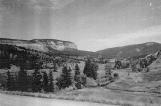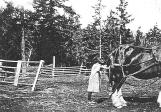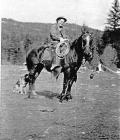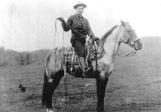1
Bud Walters, Cowboy and Pioneer of Deadman's CreekClyde Brenton Walters, who became known to his friends simply as Bud, was born in Buffalo Township, Pennsylvania, in1880. His father John Albert Walters was a blacksmith; his mother Ellen died when Bud was only 2 years old. His father re-married three years later, but Bud did not get along well with his stepmother.
At the age of fourteen, Bud's school days were over and it was time to look for a job. Although there were lots of employment opportunities in Butler County (he could have gotten a job in a glass factory, a wire cable factory, or in the oil industry), he yearned for adventure and wanted to be a cowboy. On a Spring day in 1894, he climbed up the metal rungs of a southbound box car and rode a series of freight trains until he arrived in Texas.
He was hired immediately by a big ranch in the Texas panhandle as a horse wrangler, who looks after the saddle horses and pack animals used to herd cattle. Every morning before daybreak, he swam the shallow Canadian River, rounded up 75 horses, then forded them back across to the corral ready for the riders by sun-up. The following spring, now fifteen years old, Bud joined a cattle drive from Texas northwest through New Mexico and Arizona. He had a large number of horses to look after - each cowboy had from five to twelve head - and made twenty dollars a month and board.
After that trail job he traveled to California, through Los Angeles and San Francisco, then rode east through Nevada to Wyoming. Over the next few years, he worked at several large cattle ranches in Wyoming and Montana, until he crossed the border into Canada in 1902. He moved to Medicine Hat, where he worked at a big horse ranch, the Ford Ranch, supplying work horses to the thousands of homesteaders from overseas and across the border that poured into Alberta like an invasion. Land for immigrants was dirt cheap - ten dollars and the promise to work the land for three years would get a settler 160 acres. Bud was interested in getting a homestead, but by the time he arrived in Alberta, all the good land along the railroad belt had been taken, so he decided to go north.
He was heading for the Peace River District, but encountered various troubles on his trip and ended up cowboying and breaking horses in Saskatchewan and Alberta for two years.
3
By 1904, Bud was 24 years old. He had been a cowboy in almost every western state and territory, but life as a cowboy was rapidly changing. Homesteaders were ploughing the land, barbed wire fences were criss-crossing the country, and railroads had ended the long cattle drives. Bud decided to go to South America, as he had read about great cattle ranches in Argentina.In the spring of 1905, he stopped off in Kamloops to collect a debt owed him by a friend. While he waited for his friend, Bud ended up at the stockyards, watching horses being loaded into railway cars. A foreman for the Douglas Lake Cattle Company happened to notice Bud demonstrating his skill with a lasso and hired him for $50 a month to break horses.
He was only there for one month when he ruptured his appendix taming a big black stallion in the corral. He was driven in a horse buggy over 30 miles of rough road to the Kamloops hospital, where his became the first appendix operation performed there. Bud almost died and remained in the hospital for eighteen weeks. After his release, he went to Ashcroft and hired on a s a stagecoach driver for the section of the Cariboo Road between Ashcroft and Mile 83, which was a full day's drive.
The winter of 1906-07 was very cold, and one morning, when temperatures were well below zero, he picked up several Chinese businessmen, who were on their way north to look at some gold mines in the Barkerville area. Somewhere around the 70-Mile House, as Bud was slowly taking the stagecoach up a long steep hill, his passengers - unknown to him - got out and trotted alongside the stagecoach to warm up. The road soon leveled off and the stagecoach began to pick up speed. All his passengers except one managed to get back inside, but the one who was left behind froze to death. At the inquest, Bud was exonerated for any wrongdoing. Seated in the icy wind on the driver's seat, he had no idea that his passengers had got off. With his collar and hat pulled up over his ears he did not hear their yells over the clatter of the horses and stagecoach.
4
Deadman's Creek Valley20th Century
Circle W Ranch, Deadman's Creek Valley, British Columbia, Canada
 Credits:
Credits:Edward Villiers
5
While working as a stagecoach driver, Bud met a pretty waitress named Dorothea Oppenheim at the Ashcroft Hotel and Restaurant, who would become his wife. They were married in 1907, and registered a homestead in Back Valley between Cache Creek and Deadman's Creek, where Bud built a cabin for himself and Dora. He found work on a small ranch owned by a Mr. L.H. Beamish on nearby Deadman's Creek. Beamish called his place Cultus Lake Ranch, after narrow strip of boggy ground full of reeds, bull rushes, and swamp grass that cut through the middle of a field. In the Chinook language, "Cultus" means worthless or bad.When a combination irrigation canal and wooden flume six feet wide, thirty inches deep, and twenty miles long was built from Snohoosh Lake on the upper Deadman's Creek in 1909 to water the arid fields of the British colony of Walhachin, Bud quit his job at the Beamish ranch and helped build the irrigation system. The sun-bleached planks from this aqueduct can still be seen today, hanging from the rocks above the Trans-Canada Highway opposite Walhachin.
7
When the flume project ended, Bud found work as a teamster hauling logs to the Monarch Sawmill at Savona, and was hired by Lord Angelsey in 1912 as one of the cowboys for his cattle ranch. Bud, Dora, their children and abandoned their lonely homestead and moved to Walhachin. Bud was happy to have the job with the marquis, but in his heart he wanted his own ranch, and the Beamish ranch was the one he had in mind.In 1914, Bud went into partnership with a Vancouver businessman named Harry Devane, and they bought Beamish's Cultus Lake Ranch. Devane never lived on the place, and even the Walters did not occupy the ranch themselves until 1920. The rented it out the lived alternately in Walhachin or Savona so that their children - they had five by now - could attend school.
In 1920, Bud brought his family and a small herd of Hereford cattle to the ranch. He registered a cattle brand and chose as his trademark as circle with the letter W inside it. His ranch became known as the Circle W.
In 1924, a fire destroyed their log house, but undaunted, Bud hired horse teams, carpenters and labourers to dismantle a deserted house at Walhachin, bring it to the ranch, and re-erect it on its new site. In the meantime, the family lived in a ranch outbuilding. They moved into their new house just before Christmas 1924. The house was serviced by hot and cold running water in the kitchen, and in 1930 Bud installed a flush toilet and a bath tub.
Their six children, Douglas, Vi, Myrtle, Rita, Jack, and June were taught how to ride horses, round up calves for branding, castrate bulls, weld, shoe horses, butcher beef, and how to make a diamond hitch. Before they were in their teens, he gave them the responsibility of herding cattle up to the summer range or taking small herds twenty miles down to the railroad at Savona for shipment to Vancouver. He also showed them how to build roads, operate a sawmill, and drive a car before they were in their teens. His youngest daughter June was only 8 years old when she was driving a big Clyde mare hooked to a derrick that loaded hay into stacks. At age ten she was operating a hay rake.
8
Walters, JuneCirca 1927
Circle W Ranch, Deadman's Creek Valley, British Columbia, Canada
 Credits:
Credits:Edward Villiers
9
The Walters family always had a good relationship with their Native neighbours, the Skeetchestn Indian Band. They were always welcome on the reserve. For amusement during the summer, the band organized amateur rodeos in their corral every two weeks. Bud, with his background in cowboying, was usually the judge. Dora would bring an ice cream maker, a gallon of cream, some vanilla flavouring, and a big block of ice, in the family's six-cylinder Chalmers touring car. The Walters children took turns cranking the handle until everybody on the reserve had their fill of ice cream.Bud had not lived at the Circle W very long when he watched Natives from the reserve passing through his place on horseback with several packhorses. When they returned, the horses were laden with smoked fish. They told Bud that they caught the trout in a lake about twelve miles up a trail, and that the lake was swimming with fish. They called the like "Hihiume", which meant "place where there are many fish".
Bud visited the lake and confirmed that it was an angler's paradise, which would change the course of his life.
In 1925, the government began rebuilding of the Cariboo Wagon Road, parts of which were destroyed in 1880 during the construction of the Canadian Pacific Railway. When Bud heard about that, he told a group of men "When that road re-opens, the future is in tourism, boys". He immediately began construction of a fishing lodge at Hihiume Lake to cater to tourists who would drive their vehicles over that new road.
10
Walters, BudCirca 1932
Circle W Ranch, Deadman's Creek Valley, British Columbia, Canada
 Credits:
Credits:Edward Villiers
11
Using packhorses, Bud moved tools and building materials to Hihiume Lake and built five cabins. In October 1926, the new highway was opened for five days, before it closed again for further construction until the spring. During that brief period, the Walters fishing lodge welcomed its first tourists, who drove up from Vancouver. They were escorted to the lake on saddle horses and enjoyed themselves immensely.In 1927, after the official reopening of the highway, American tourists from Washington state quickly replaced Walter's first guests from Vancouver. Bud never formally advertised his new resort, his guests all heard about his place by word of mouth.
12
Walters, RitaCirca 1930 (?)
Circle W Ranch, Deadman's Creek Valley, British Columbia, Canada
 Credits:
Credits:Edward Villiers
13
Three years after he opened the fishing camp, Bud built a road into it wide enough for a horse-drawn two wheel cart, helped by his children. In 1933, he moved his three-man sawmill from the ranch to a plateau above the Vidette gold mine, nineteen miles upstream from the Circle W, and began building boats for his tourist business, which had now expanded to Bonaparte Lake. He also opened up Bare Lake, Heller Lake, Babe Lake, Tingley Lake, and Scotty Lake to the fishermen. At first, all this was done with pack horses, then teams, and lastly by a rough truck road with many bogs covered by corduroy.In 1935, when Bud's daughter June was only 16, she and her older sister Rita became the first two female licensed guides in Canada.
14
Walters, June20th Century, Circa 1945
Circle W Ranch, Deadman's Creek Valley, British Columbia, Canada
 Credits:
Credits:Edward Villiers

